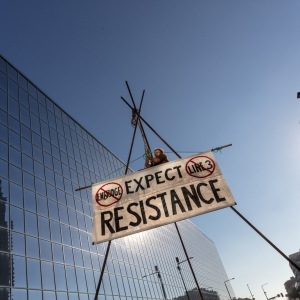Federal Water Tap, June 28: Infrastructure Deal Details Yet to Emerge
The Rundown
- Ten senators settled on an infrastructure package.
- A federal watchdog says that the Defense Department should report more information to Congress on PFAS cleanup costs.
- The Army Corps of Engineers will proceed with an environmental impact statement for the Line 5 oil pipelines, in northern Michigan.
- Three water-related bills move out of the House Energy and Commerce Committee.
- USGS researchers measure groundwater changes in the upper Rio Grande basin.
- The EPA outlines $50 million in environmental justice
And lastly, above-average temperatures are expected in the western states this summer, meaning little relief for dry landscapes.
“I clearly didn’t get all I wanted. They gave more than, I think, maybe they were inclined to give in the first place.” — President Joe Biden discussing the infrastructure deal struck with a bipartisan group of senators.
By the Numbers
$50 million: American Rescue Plan funding that the Environmental Protection Agency will direct toward environmental justice programs. The spending outline includes $4.7 million for technical assistance to rural and tribal drinking water systems and $5.1 million to monitor drinking water pollution near low-income communities. The monitoring is intended to support compliance and enforcement efforts.
News Briefs
They Made A Deal
Five Republican and five Democratic senators joined with President Biden to announce a $1.2 trillion infrastructure package, which includes $579 billion in new spending.
For water, the deal is less ambitious than the president had hoped. It includes $55 billion for water infrastructure, down from the $111 billion in Biden’s initial proposal. The deal adds $5 billion for water storage in the western states, which are reeling from drought. There is also $47 billion for climate resilience.
Beyond the top-line numbers, there were no details about how the funding would be allocated among various federal water programs. The Biden administration claims that the deal would eliminate lead service lines, but the funding falls short of the need — unless almost all of the $55 billion goes toward removing lead pipes. (The initial Biden proposal earmarked $45 billion just for lead pipes.)
Tommy Holmes, legislative director for the American Water Works Association, said that his group, which represents water utilities, is in the dark.
Holmes wrote to Circle of Blue: “This is the challenge posed by big, top-line proposals: we don’t know the details and to the sectors affected, details are everything.”
The package still must traverse the Senate and House.
Line 5 Environmental Review
The Army Corps of Engineers will undertake an environmental impact statement for oil transport infrastructure in northern Michigan.
Line 5 is a pair of pipelines that move oil and petroleum products across the Straits of Mackinac, the body of water that divides Lake Michigan and Lake Huron. Enbridge, the company that owns Line 5, wants to build a tunnel to house the pipelines. They currently rest on the lake bed and are subject to shutdown orders from Gov. Gretchen Whitmer.
House Committee Advances Water Bills
The House Energy and Commerce Committee advanced three water-related bills to the full House. The bills would require PFAS be designated as hazardous substances under the federal Superfund law, require drinking water standards for microcystin and 1,4-dioxane, and establish a program through the EPA to help low-income households pay their water and sewer bills.
Studies and Reports
Defense Department PFAS Cleanup Costs
A federal watchdog agency says that the Defense Department should report more information to Congress on the expected cost of cleaning up PFAS contamination at military bases.
The Defense Department estimates that future cleanup costs will be at least $2.1 billion. But the Government Accountability Office report notes that those financial liabilities will increase as the department continues to investigate contaminated sites.
Groundwater Changes in Upper Rio Grande
The U.S. Geological Survey investigated changes in groundwater storage in basins along the upper Rio Grande, from 1980 to 2015. Changes varied by basin, but more exhibited declines.
On the Radar
Klamath Dam Removal Environmental Review
Federal energy regulators will begin public scoping for an environmental impact statement on removing four dams on the Klamath River. The draft EIS is expected in February 2022.
Legislative Hearing
On June 29, a House subcommittee will discuss bills on water recycling, Salton Sea, a correction to the water rights settlement for the Shoshone-Paiute Tribes of the Duck Valley Reservation, and the Milk River Project in Montana.
Coal Ash Hearing
On June 30, a House subcommittee will hold a hearing on coal ash waste in Puerto Rico.
Drought Forecast
Don’t expect any drought relief for the western states any time soon. NOAA’s three-month outlook shows a high probability for above-average temperatures.
In context: Drought, The Everything Disaster
Federal Water Tap is a weekly digest spotting trends in U.S. government water policy. To get more water news, follow Circle of Blue on Twitter and sign up for our newsletter.
Brett writes about agriculture, energy, infrastructure, and the politics and economics of water in the United States. He also writes the Federal Water Tap, Circle of Blue’s weekly digest of U.S. government water news. He is the winner of two Society of Environmental Journalists reporting awards, one of the top honors in American environmental journalism: first place for explanatory reporting for a series on septic system pollution in the United States(2016) and third place for beat reporting in a small market (2014). He received the Sierra Club’s Distinguished Service Award in 2018. Brett lives in Seattle, where he hikes the mountains and bakes pies. Contact Brett Walton






Leave a Reply
Want to join the discussion?Feel free to contribute!